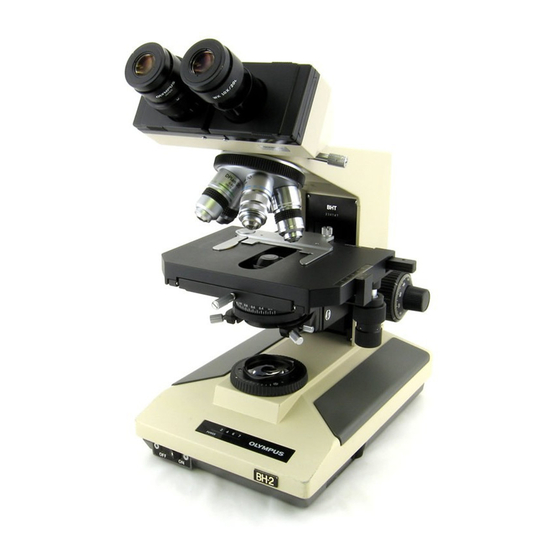Olympus BH-2 BHTU Podręcznik - Strona 4
Przeglądaj online lub pobierz pdf Podręcznik dla Mikroskop Olympus BH-2 BHTU. Olympus BH-2 BHTU 24 stron. Sliding focus block
Również dla Olympus BH-2 BHTU: Kompletny demontaż, czyszczenie i ponowny montaż (23 strony)

Resistor R201, the current‐sensing resistor, is effectively in series with the halogen lamp. So long as the lamp current
remains within the normal range, the resulting voltage drop across resistor R201 is insufficient to initiate conduction of
transistor Q202, and the dimmer operates as described in the paragraphs above. However, if for any reason the lamp
current gets high enough that the voltage drop across resistor R201 is sufficient to turn on transistor Q202, the resulting
collector current of transistor Q202 shunts the base‐emitter junction of transistor Q201, reducing its base current and in
turn reducing the lamp current. This negative‐feedback mechanism limits the peak lamp current to approximately 7.3A.
Capacitor C202 provides low‐pass filtering for the base of transistor Q202, preventing any high frequency noise or RF
from affecting the lamp dimmer.
Figure
21,
Figure
22, and
Figure
23 show the voltage and current waveforms of the halogen lamp with the dimmer
operating at the 100%, 50%, and 20% settings of the intensity control, respectively.
Figure
24 shows the dimmer
operating under current‐limiting conditions at the 80% setting of the intensity control and with an abnormally low lamp
resistance of 0.2 Ω.
LED Bar‐Graph Display Circuitry
Figure
3 is a simplified schematic diagram of the LED bar‐graph display circuitry. This diagram contains the details
necessary for an understanding of the basic operation of the LED circuitry. Unnecessary details such as such as
switching, fusing, and electrical interconnects have been omitted for clarity. Refer to Appendix 2 and Appendix 3 of this
document for complete and detailed schematic diagrams of the BHT/BHTU electronics.
This circuit successively illuminates the four LEDs in the bar‐graph module as the intensity control is moved from its
minimum setting to its maximum setting. The variable output from the wiper of potentiometer RV101 acts as the
control signal for the LED display circuitry (as well as for the dimmer circuit described earlier), which feeds the non‐
inverting inputs of four op‐amps used as comparators. The control signal is at maximum amplitude at the minimum
intensity setting, and is at zero amplitude at the maximum intensity setting. The four comparators each have specific
switching thresholds, which are configured to allow the comparators to illuminate the LEDs at four pre‐defined lamp
voltages of 2V, 4V, 6V, and 7V, in response to the decreasing control signal from the intensity potentiometer.
Figure 3 – BHT/BHTU LED Bar‐Graph Display Circuitry
Olympus BH‐2 (BHT/BHTU) Electronics
Revision 2
Page 4 of 24
